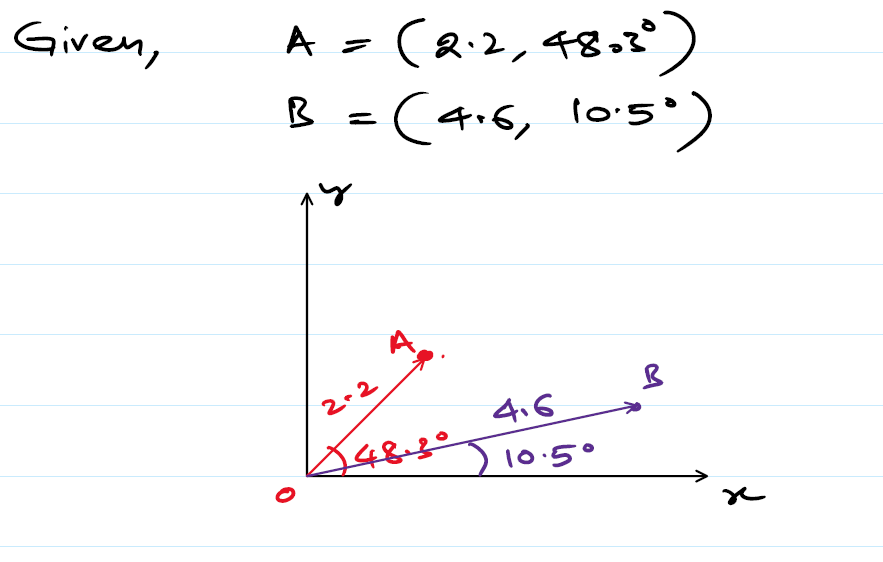College Physics
11th Edition
ISBN:9781305952300
Author:Raymond A. Serway, Chris Vuille
Publisher:Raymond A. Serway, Chris Vuille
Chapter1: Units, Trigonometry. And Vectors
Section: Chapter Questions
Problem 1CQ: Estimate the order of magnitude of the length, in meters, of each of the following; (a) a mouse, (b)...
Related questions
Question
![### Polar Coordinates Distance Calculation
**Problem Statement:**
Two plane polar coordinates have the coordinates \((2.2, 48.3^\circ)\) and \((4.6, 10.5^\circ)\). Calculate the distance between them. Round your answer to 1 decimal place.
**Detailed Explanation:**
In polar coordinates, a point in the plane is represented as \((r, \theta)\), where:
- \(r\) is the radial distance from the origin.
- \(\theta\) is the angular coordinate (or angle) in degrees.
To find the distance \(d\) between two points \((r_1, \theta_1)\) and \((r_2, \theta_2)\) in polar coordinates, you can use the formula:
\[ d = \sqrt{r_1^2 + r_2^2 - 2 r_1 r_2 \cos(\theta_2 - \theta_1)} \]
1. For the coordinates \((r_1, \theta_1) = (2.2, 48.3^\circ)\):
- \(r_1 = 2.2\)
- \(\theta_1 = 48.3^\circ\)
2. For the coordinates \((r_2, \theta_2) = (4.6, 10.5^\circ)\):
- \(r_2 = 4.6\)
- \(\theta_2 = 10.5^\circ\)
Convert the angular difference \((\theta_2 - \theta_1)\) to radians if necessary, or use the cosine of the difference directly in degrees:
\[ \cos((\theta_2 - \theta_1)^\circ) = \cos(10.5^\circ - 48.3^\circ) \]
Then, substitute the values into the formula to compute the distance \(d\).
**Note for Educational Websites:**
- Ensure that students understand how to convert between degrees and radians if needed.
- Explain the cosine function and its significance in the formula.
- Provide step-by-step calculations and intermediate results to enhance understanding.
Remember to use appropriate mathematical notation and clarify each step for better readability and comprehension.](/v2/_next/image?url=https%3A%2F%2Fcontent.bartleby.com%2Fqna-images%2Fquestion%2Ff3b22dc5-b81c-452b-a8fe-ec73685697af%2Ff6de1451-edd9-4fb1-9317-91d862fbd41a%2Ftig1tve.jpeg&w=3840&q=75)
Transcribed Image Text:### Polar Coordinates Distance Calculation
**Problem Statement:**
Two plane polar coordinates have the coordinates \((2.2, 48.3^\circ)\) and \((4.6, 10.5^\circ)\). Calculate the distance between them. Round your answer to 1 decimal place.
**Detailed Explanation:**
In polar coordinates, a point in the plane is represented as \((r, \theta)\), where:
- \(r\) is the radial distance from the origin.
- \(\theta\) is the angular coordinate (or angle) in degrees.
To find the distance \(d\) between two points \((r_1, \theta_1)\) and \((r_2, \theta_2)\) in polar coordinates, you can use the formula:
\[ d = \sqrt{r_1^2 + r_2^2 - 2 r_1 r_2 \cos(\theta_2 - \theta_1)} \]
1. For the coordinates \((r_1, \theta_1) = (2.2, 48.3^\circ)\):
- \(r_1 = 2.2\)
- \(\theta_1 = 48.3^\circ\)
2. For the coordinates \((r_2, \theta_2) = (4.6, 10.5^\circ)\):
- \(r_2 = 4.6\)
- \(\theta_2 = 10.5^\circ\)
Convert the angular difference \((\theta_2 - \theta_1)\) to radians if necessary, or use the cosine of the difference directly in degrees:
\[ \cos((\theta_2 - \theta_1)^\circ) = \cos(10.5^\circ - 48.3^\circ) \]
Then, substitute the values into the formula to compute the distance \(d\).
**Note for Educational Websites:**
- Ensure that students understand how to convert between degrees and radians if needed.
- Explain the cosine function and its significance in the formula.
- Provide step-by-step calculations and intermediate results to enhance understanding.
Remember to use appropriate mathematical notation and clarify each step for better readability and comprehension.
Expert Solution
Step 1

Step by step
Solved in 2 steps with 3 images

Knowledge Booster
Learn more about
Need a deep-dive on the concept behind this application? Look no further. Learn more about this topic, physics and related others by exploring similar questions and additional content below.Recommended textbooks for you

College Physics
Physics
ISBN:
9781305952300
Author:
Raymond A. Serway, Chris Vuille
Publisher:
Cengage Learning

University Physics (14th Edition)
Physics
ISBN:
9780133969290
Author:
Hugh D. Young, Roger A. Freedman
Publisher:
PEARSON

Introduction To Quantum Mechanics
Physics
ISBN:
9781107189638
Author:
Griffiths, David J., Schroeter, Darrell F.
Publisher:
Cambridge University Press

College Physics
Physics
ISBN:
9781305952300
Author:
Raymond A. Serway, Chris Vuille
Publisher:
Cengage Learning

University Physics (14th Edition)
Physics
ISBN:
9780133969290
Author:
Hugh D. Young, Roger A. Freedman
Publisher:
PEARSON

Introduction To Quantum Mechanics
Physics
ISBN:
9781107189638
Author:
Griffiths, David J., Schroeter, Darrell F.
Publisher:
Cambridge University Press

Physics for Scientists and Engineers
Physics
ISBN:
9781337553278
Author:
Raymond A. Serway, John W. Jewett
Publisher:
Cengage Learning

Lecture- Tutorials for Introductory Astronomy
Physics
ISBN:
9780321820464
Author:
Edward E. Prather, Tim P. Slater, Jeff P. Adams, Gina Brissenden
Publisher:
Addison-Wesley

College Physics: A Strategic Approach (4th Editio…
Physics
ISBN:
9780134609034
Author:
Randall D. Knight (Professor Emeritus), Brian Jones, Stuart Field
Publisher:
PEARSON